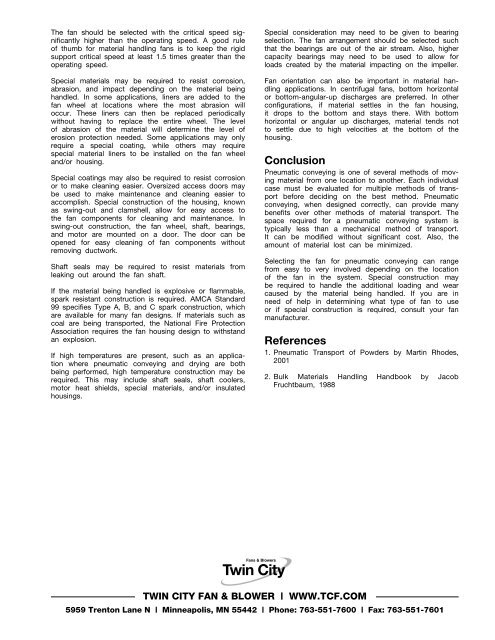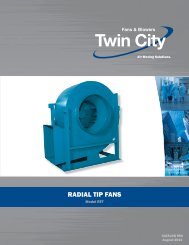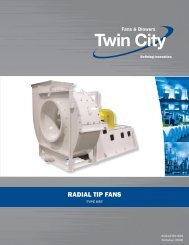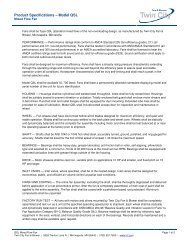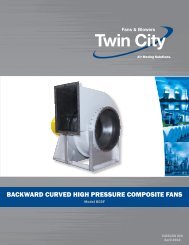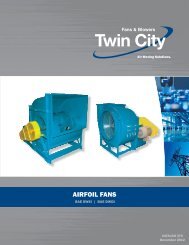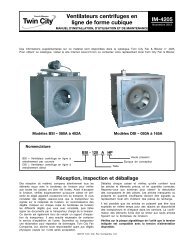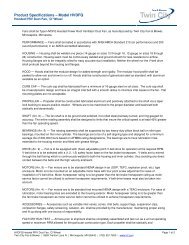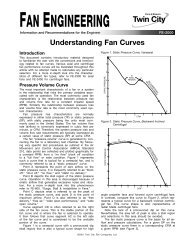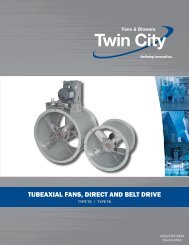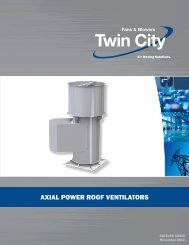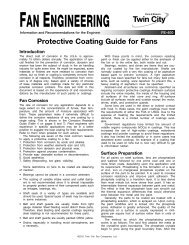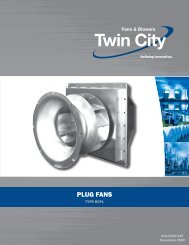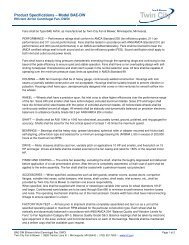The Use of Fans in Pneumatic Conveying - Twin City Fan & Blower
The Use of Fans in Pneumatic Conveying - Twin City Fan & Blower
The Use of Fans in Pneumatic Conveying - Twin City Fan & Blower
You also want an ePaper? Increase the reach of your titles
YUMPU automatically turns print PDFs into web optimized ePapers that Google loves.
<strong>The</strong> fan should be selected with the critical speed significantlyhigher than the operat<strong>in</strong>g speed. A good rule<strong>of</strong> thumb for material handl<strong>in</strong>g fans is to keep the rigidsupport critical speed at least 1.5 times greater than theoperat<strong>in</strong>g speed.Special materials may be required to resist corrosion,abrasion, and impact depend<strong>in</strong>g on the material be<strong>in</strong>ghandled. In some applications, l<strong>in</strong>ers are added to thefan wheel at locations where the most abrasion willoccur. <strong>The</strong>se l<strong>in</strong>ers can then be replaced periodicallywithout hav<strong>in</strong>g to replace the entire wheel. <strong>The</strong> level<strong>of</strong> abrasion <strong>of</strong> the material will determ<strong>in</strong>e the level <strong>of</strong>erosion protection needed. Some applications may onlyrequire a special coat<strong>in</strong>g, while others may requirespecial material l<strong>in</strong>ers to be <strong>in</strong>stalled on the fan wheeland/or hous<strong>in</strong>g.Special coat<strong>in</strong>gs may also be required to resist corrosionor to make clean<strong>in</strong>g easier. Oversized access doors maybe used to make ma<strong>in</strong>tenance and clean<strong>in</strong>g easier toaccomplish. Special construction <strong>of</strong> the hous<strong>in</strong>g, knownas sw<strong>in</strong>g-out and clamshell, allow for easy access tothe fan components for clean<strong>in</strong>g and ma<strong>in</strong>tenance. Insw<strong>in</strong>g-out construction, the fan wheel, shaft, bear<strong>in</strong>gs,and motor are mounted on a door. <strong>The</strong> door can beopened for easy clean<strong>in</strong>g <strong>of</strong> fan components withoutremov<strong>in</strong>g ductwork.Shaft seals may be required to resist materials fromleak<strong>in</strong>g out around the fan shaft.If the material be<strong>in</strong>g handled is explosive or flammable,spark resistant construction is required. AMCA Standard99 specifies Type A, B, and C spark construction, whichare available for many fan designs. If materials such ascoal are be<strong>in</strong>g transported, the National Fire ProtectionAssociation requires the fan hous<strong>in</strong>g design to withstandan explosion.If high temperatures are present, such as an applicationwhere pneumatic convey<strong>in</strong>g and dry<strong>in</strong>g are bothbe<strong>in</strong>g performed, high temperature construction may berequired. This may <strong>in</strong>clude shaft seals, shaft coolers,motor heat shields, special materials, and/or <strong>in</strong>sulatedhous<strong>in</strong>gs.Special consideration may need to be given to bear<strong>in</strong>gselection. <strong>The</strong> fan arrangement should be selected suchthat the bear<strong>in</strong>gs are out <strong>of</strong> the air stream. Also, highercapacity bear<strong>in</strong>gs may need to be used to allow forloads created by the material impact<strong>in</strong>g on the impeller.<strong>Fan</strong> orientation can also be important <strong>in</strong> material handl<strong>in</strong>gapplications. In centrifugal fans, bottom horizontalor bottom-angular-up discharges are preferred. In otherconfigurations, if material settles <strong>in</strong> the fan hous<strong>in</strong>g,it drops to the bottom and stays there. With bottomhorizontal or angular up discharges, material tends notto settle due to high velocities at the bottom <strong>of</strong> thehous<strong>in</strong>g.Conclusion<strong>Pneumatic</strong> convey<strong>in</strong>g is one <strong>of</strong> several methods <strong>of</strong> mov<strong>in</strong>gmaterial from one location to another. Each <strong>in</strong>dividualcase must be evaluated for multiple methods <strong>of</strong> transportbefore decid<strong>in</strong>g on the best method. <strong>Pneumatic</strong>convey<strong>in</strong>g, when designed correctly, can provide manybenefits over other methods <strong>of</strong> material transport. <strong>The</strong>space required for a pneumatic convey<strong>in</strong>g system istypically less than a mechanical method <strong>of</strong> transport.It can be modified without significant cost. Also, theamount <strong>of</strong> material lost can be m<strong>in</strong>imized.Select<strong>in</strong>g the fan for pneumatic convey<strong>in</strong>g can rangefrom easy to very <strong>in</strong>volved depend<strong>in</strong>g on the location<strong>of</strong> the fan <strong>in</strong> the system. Special construction maybe required to handle the additional load<strong>in</strong>g and wearcaused by the material be<strong>in</strong>g handled. If you are <strong>in</strong>need <strong>of</strong> help <strong>in</strong> determ<strong>in</strong><strong>in</strong>g what type <strong>of</strong> fan to useor if special construction is required, consult your fanmanufacturer.References1. <strong>Pneumatic</strong> Transport <strong>of</strong> Powders by Mart<strong>in</strong> Rhodes,20012. Bulk Materials Handl<strong>in</strong>g Handbook by JacobFruchtbaum, 1988Tw<strong>in</strong> city fan & blower | www.tcf.com5959 Trenton Lane N | M<strong>in</strong>neapolis, MN 55442 | Phone: 763-551-7600 | Fax: 763-551-7601


